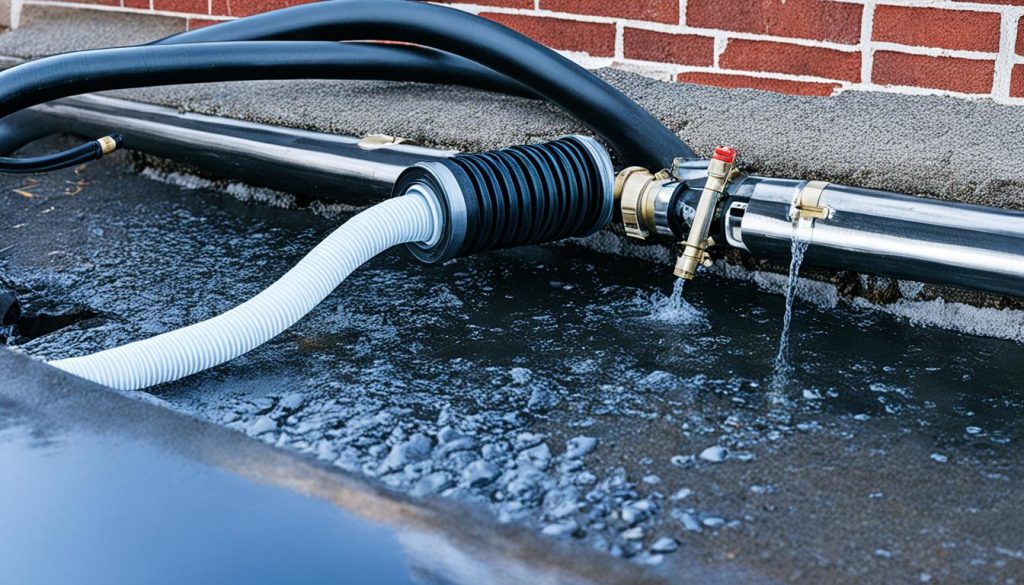Fix a Clogged Condensate Drain Line Fast!
Did you know that a clogged condensate drain line can cause water to back up in your HVAC system and lead to flooding? It’s a major headache for homeowners, and it’s important to address the issue promptly. Fortunately, there are several methods you can try to quickly unclog your AC’s drain line and get your system back up and running efficiently.
Key Takeaways:
- Addressing a clogged condensate drain line promptly is crucial to avoid system malfunctions and potential flooding.
- Methods such as using a plunger, wet/dry vacuum, vinegar or bleach, blowing air through the line, flushing clean water, and utilizing chemical drain cleaners or an electric snake can help clear clogs.
- If the problem persists or if you’re unsure of how to proceed, it’s best to seek professional help.
Plunger Method
The plunger method is a common first solution for clearing clogs in a drain line. While it may not be effective for all types of clogs, it’s worth a try. You may need more than one plunger depending on the number of clogged drains. Keep in mind that plungers are relatively inexpensive and easy to find, making them a convenient tool for tackling clogs.
How to Use a Plunger to Clear Clogs
To use a plunger to clear clogs in a drain line, follow these steps:
- Fill the sink, tub, or toilet with enough water to cover the plunger’s rubber cup.
- Place the plunger over the drain opening, ensuring a tight seal.
- Push down and pull up on the plunger forcefully, creating suction to dislodge the clog.
- Repeat the process several times, maintaining a steady rhythm until the water begins to drain.
- If the clog persists, you may need to try alternative methods or seek professional help.
By using the plunger method, you can often clear minor clogs in your drain line and restore proper functionality to your plumbing system.
Use a Wet/Dry Vacuum
If you’re dealing with solid debris clogging your drain line, using a wet/dry vacuum can be a highly effective solution. The advantage of a wet/dry vacuum is its ability to handle standing water, making it perfect for this task.
To begin, ensure that you remove any caps or plugs from the end of the drain line before attempting to use the vacuum. By doing so, you’ll create a clear path for the powerful suction of the vacuum to pull out the debris.
Position the wet/dry vacuum at one end of the drain line and turn it on. Allow the vacuum to draw in the solid debris, effectively unclogging the line. Be sure to maintain a firm seal between the vacuum hose and the drain line to optimize suction.
As the debris is pulled out, you may notice some water being drawn into the vacuum. This is normal and indicates that the wet/dry vacuum is successfully removing both the solid debris and any standing water in the drain line.
Remember to empty the vacuum’s collection tank as needed, especially if there is a significant amount of debris in your drain line. By effectively using a wet/dry vacuum, you can quickly and efficiently clear the clog, ensuring proper drainage in your HVAC system.
Pour Vinegar or Bleach Down the Drain Line
Vinegar and bleach are natural disinfectants that can break down algae, bacteria, and mold in your drain line. To use vinegar, turn off your air conditioner and pour one cup of white vinegar into the condensate pan through the access port. If there is no access port, pour the vinegar into a bucket and place it in the condensate pan. Let the vinegar sit for about 30 minutes before turning your AC back on. To use bleach, pour one cup of bleach down the drain line every month to prevent clogs and kill bacteria. Be careful not to mix bleach with any other chemicals.
Note: Ensure proper precautions are taken when working with bleach, and always follow the instructions on the label. Additionally, avoid using bleach if you have a septic system, as it can harm the natural bacteria needed for proper septic tank function.
Benefits of Vinegar and Bleach in Clearing the Drain Line
When poured down the drain line, vinegar and bleach have several benefits in effectively unclogging and maintaining the drain line:
- Disinfectant properties: Vinegar and bleach have antimicrobial properties, which can kill algae, bacteria, and mold that may be clogging the drain line.
- Breaks down organic matter: Algae and mold thrive in damp environments, such as condensate pans. Vinegar and bleach can break down these organic substances, preventing them from accumulating and causing clogs.
- Economical solution: Both vinegar and bleach are affordable and readily available cleaning agents, making them convenient options for homeowners.
Regular use of vinegar or bleach can help prevent clogs in the drain line, maintain optimal system performance, and promote a healthier indoor environment.
Precautions When Using Vinegar or Bleach
While vinegar and bleach can be effective in clearing the drain line, it’s important to exercise caution. Here are some precautions to keep in mind:
- Do not mix vinegar and bleach together. Combining these substances can produce harmful fumes.
- Use white vinegar, as it is the most suitable type for this application. Avoid using any other types of vinegar, as they may contain additives that could potentially harm the drain line.
- When pouring vinegar down the access port or into a bucket, be mindful of spills and use a funnel if necessary to prevent any mess.
- Wear gloves and protective eyewear when handling bleach to avoid skin and eye irritation.
- Follow the manufacturer’s instructions when using bleach, and always dilute it with water as directed.
| Vinegar | Bleach |
|---|---|
| Natural disinfectant | Kills bacteria |
| Breaks down algae and mold | Prevents clogs |
| Safe for most drain lines | Affordable and readily available |
Using vinegar or bleach to clear the drain line can be an effective and economical solution for maintaining a clog-free HVAC system. However, if the clogging persists or if you are unsure about performing these maintenance tasks, it is recommended to seek professional help to prevent any further damage or potential safety hazards.
Blow Air Through the Line
Another option to clear stubborn clogs from your drain line is to blow air through it. This method can help dislodge any debris that may be causing the blockage. Here are a few tools you can use:
- Air Compressor: If you have access to an air compressor, it can be a powerful tool for blowing air through the line. Attach the air compressor to the end of the drain line and set it to a medium pressure. Slowly blow the air through the line, starting at the condenser and moving towards the outside unit. This will help push out any debris that may be stuck.
- Bicycle Pump: If you don’t have an air compressor, a bicycle pump can be a suitable alternative. Attach the pump to the end of the drain line and pump air through the line in short bursts. Be sure to maintain a steady pressure to dislodge any debris.
- Garden Hose with Rag: If neither an air compressor nor a bicycle pump is available, a garden hose with a rag over the end can still do the trick. Make sure to tightly secure the rag to the end of the hose to prevent water from splashing back. Use the hose to blow air through the line, following the same process as with the other methods.
Regardless of the tool you choose, start at the condenser and move towards the outside unit, feeling for any blockages along the way. Take your time and apply consistent pressure to ensure effective clearing of the debris.
Blowing air through the line is a simple yet effective method that can help you unclog your drain line and restore proper functioning to your AC system.
Flush Clean Water Through It
Flushing clean water through the drain line can help loosen any debris that may be stuck. Turn off your AC and detach the drain line from underneath. Attach a hose to it and run water through it for several minutes or until the water comes out clean. This will increase water pressure in the drain and push out any lodged debris. Repeat the process if necessary until the drain line is clear.
Use Chemical Drain Cleaners or Electric Snake
If none of the previous methods work, you can try using chemical drain cleaners specifically designed for unclogging drains. These products need to be mixed with water and left in place for several hours to break down clogs. However, it’s important to follow the instructions carefully and use these cleaners with caution, as they can be harsh and may damage your pipes or fixtures if used incorrectly.
Another option to consider is using an electric snake, a machine with a rotating brush that can dislodge stubborn debris. The electric snake is inserted into the clogged drain line, and its rotating brush helps break up the clog and clear the blockage. It’s important to note that using an electric snake requires knowledge of plumbing and electrical work, so it’s best to leave it to professionals if you’re not confident in your abilities.
When it comes to more complex or persistent clogs, it’s always a good idea to seek professional help. A licensed plumber has the expertise and specialized equipment to effectively diagnose and resolve the issue. They can safely use chemical drain cleaners or employ advanced techniques like hydro jetting to clear your drain line and restore proper functioning to your plumbing system.
- Investing Wisely: How Windows & Doors in Boost Property Value and Financial Health - April 24, 2025
- The Financial Impact of Personal Injuries: Why Legal Help Matters for Business Owners - April 16, 2025
- The Hidden Financial Costs of Domestic Assault: What Business Owners Need to Know - April 16, 2025














